Space weather effects on technology
Space weather phenomena have a variety of effects on technology. Energetic particles thrown out from the sun interact with the earth's magnetic field producing magnetic disturbances and increased ionization in the ionosphere, 100 to 1000 km above the earth. The high energy particles affect satellites causing misoperation or equipment damage that can put the satellite out of operation. Radio waves used for satellite communications or GPS navigation are affected by the increased ionization with disruption of the communication or navigation systems. The magnetic disturbances directly affect operations that use the magnetic field, such as magnetic surveys, directional drilling, or compass use. Magnetic disturbances also induce electric currents in long conductors such as power lines and pipelines causing power system outages or pipeline corrosion.
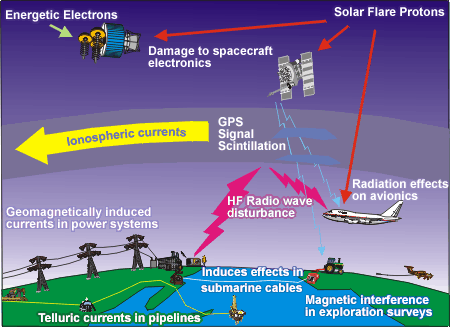
Find more information
- Power System
- Satellites
- GPS Positioning
- Pipelines
- Communication Cables
- HF Radio
- Chronology of Effects
Power System
Introduction
Geomagnetic disturbances can have a serious effect on power systems. Currents induced in power lines flow to ground through substation transformers. Here they cause saturation of the transformer core which can lead to a variety of problems. Increased heating has caused transformers to burn out. Also, extra harmonics generated in the transformer produce unwanted relay operations, suddenly tripping out power lines. The stability of the whole system can also be affected as compensators switch out of service. Such a sequence of events led to the Quebec blackout of March 13, 1989, which left the whole province without power for over 9 hours.
How GIC affect power systems
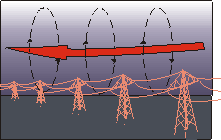
Geomagnetically induced currents (GIC) are driven by the electric fields produced by the magnetic field variations that occur during a geomagnetic disturbance. Because of their low frequency compared to the AC frequency, the geomagnetically induced currents appear to a transformer as a slowly-varying DC current. GIC flowing through the transformer winding produces extra magnetisation which, during the half-cycles when the AC magnetisation is in the same direction, can saturate the core of the transformer. This results in a very spikey AC waveform with increased harmonic levels that can cause misoperation of relays and other equipment on the system and lead to problems ranging from trip-outs of individual lines to collapse of the whole system.
Transformer Heating
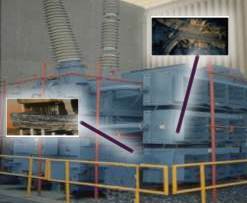
Saturation of the transformer core produces extra eddy currents in the transformer core and structural supports which heat the transformer. The large thermal mass of a high voltage power transformer means that this heating produces a negligible change in the overall transformer temperature. However, localised hot spots can occur and cause damage to the transformer windings.
Cost of Magnetic Storms
The costs to power system operators involve not only replacement of damaged equipment but also the loss of revenue from sale of power. The Quebec blackout on March 13, 1989 had a net cost of about $13.2 million; damaged equipment accounts for about $6.5 million of that estimated cost. The transformer at the Salem, New Jersey, nuclear generating station, that burnt-out during the March 13, 1989 magnetic disturbance, cost several million dollars to replace. Such expensive units are usually built to order and the delivery time is normally about one year. Unusually, in the Salem case, a replacement transformer was available and delivery and installation took only 6 weeks. Even so , having the transformer out of service restricted the power that could be delivered from the Salem generating station and the purchase of replacement power from neighbouring utilities cost about $17 million, far more than the cost of the transformer.
Increasing Vulnerability
The vulnerability of a power system to geomagnetic disturbances is increased when the system is more heavily loaded. Increasing power demand and industry deregulation have both led to power systems being operated closer to their limits making them more vulnerable to outside disturbances. A distinctive feature of GIC effects on power systems is that the problems occur simultaneously on many systems. This is contrary to other types of power system problems, eg lighting strikes or equipment failures, which are more localised. The interconnections of modern power sytems are designed to provide safeguards againts the localised failures, but may be contributing to an increased vulnerability to GIC.
Introduction
Satellites are operating in an environment populated with charged particles. These particles can affect satellites in a variety of ways, either directly by penetrating into the satellite electronics, or indirectly through spacecraft charging with the resulting discharge causing problems. These processes can result in phantom commands, damage to electronics, loss of control, and even satellite failure.
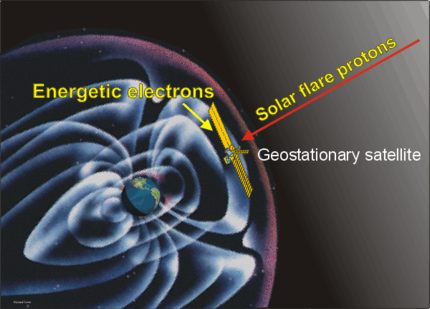
Solar Proton Effects
When high velocity ions plough through semiconductor devices they produce a large number of electrons and holes that carry currents within these devices. Large numbers of electron-hole pairs introduced into sensitive regions like memory cells can alter information and result in phantom commands. Effects can be devastating if ion impacts occur in control systems or decision-making circuits. In addition, these impacts degrade semiconductor lifetimes.
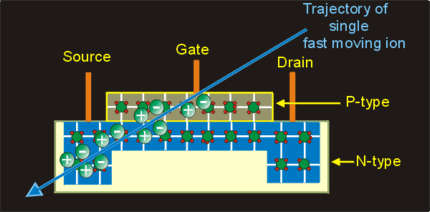
Surface charging
Surface charging of spacecraft in synchronous orbit can occur due to incidence of a large incoming flux of electrons in the absence of sufficient charge drainage by mechanisms such as photoemission. "Hot" electrons with energies in the range of several to several tens of keV are mainly responsible for surface charging. Intense fluxes of these electrons are closely related to substorm activities, hence surface charging occurs more often in the midnight to dawn sector. The differential charging of spacecraft surfaces can give rise to destructive arc discharges, causing satellite operational anomalies.
Internal Charging
The occurrence of highly energetic (relativistic) electrons with energies greater than 2 Mev represents adverse space weather conditions hazardous for geosynchronous satellites. When this happens, there is a high likelihood of internal charging of satellite components by energetic electrons, with possible electric discharges that could result in malfunction or even complete failure of the satellite. Such an event was the likely cause of a number of satellite operational anomalies in January 1994.
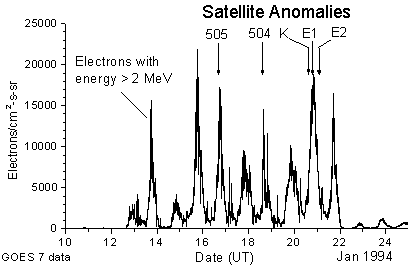
Electrostatic discharge
Electrostatic discharge results from spacecraft charging, be it surface or internal. Once the generated electric field due to charging exceeds a certain threshold, an arc discharge occurs, generating an electromagnetic transient that couples into spacecraft electronics and causes spacecraft operational anomalies. The following figure shows the local time distribution of occurrence of discharges.
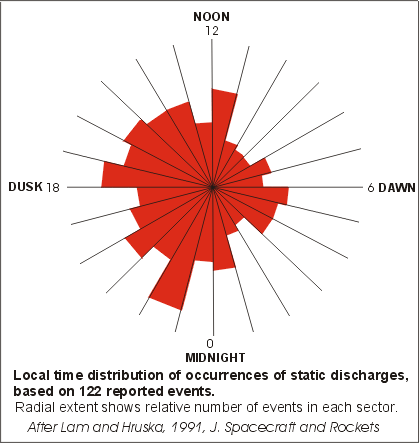
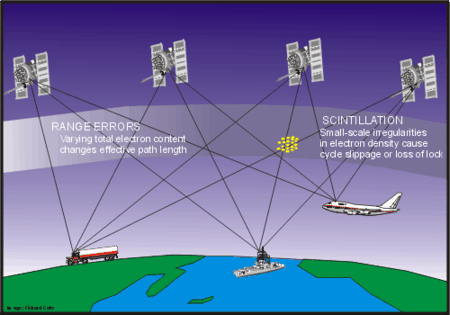
Modern navigational systems that use radio-wave signals reflecting from or propagating through the ionosphere as a means of determining range, or distance, are vulnerable to a variety of effects that can degrade performance. In particular, systems such as the Global Positioning System (GPS), that use constellations of earth-orbiting satellites, are affected by space weather phenomena. In principle, the GPS uses known positions of satellites and their distances from a receiver to determine the location of the receiver.
When charged particles ejected from the Sun arrive at the Earth, they can cause perturbations in the geomagnetic field. Another effect is that in the ionosphere the electron density (number of electrons in a given volume) can vary considerably, both in time and space.
A GPS receiver uses radio signals from several orbiting satellites to determine the range, or distance, from each satellite, and determines from these ranges the actual position of the receiver. The radio signals must pass through the ionosphere and in so doing they are subjected to variations in the electron density structure of the ionosphere. Changes in the electron density due to space weather activity can change the speed at which the radio waves travel, introducing a “propagation delay“ in the GPS signal. The propagation delay can vary from minute to minute, and such intervals of rapid change can last for several hours, especially in the polar and auroral regions. Changing propagation delays cause errors in the determination of the range, or “range errors“.
The performance of single-frequency GPS receivers using Code Phase Tracking techniques can be significantly degraded by the ionospheric propagation delays. Use of dual-frequency GPS receivers can, under some conditions, compensate for most of the ionospheric propagation delays by measuring the different delays at the two frequencies. Ionospheric delay corrections for a region can be determined from a network of precisely-positioned dual-frequency receivers and then be transmitted in near-real-time to users of single frequency GPS receivers in the region. Such a system is operated by the Canadian Active Control System of Natural Resources Canada.
Another GPS technique uses Carrier Phase Tracking. In this technique, the phases of individual cycles of the carrier waves are compared. However, if the electron density along a signal path from a satellite to a receiver changes very rapidly, as a result of space weather disturbances, the resulting rapid change in the phase of the radio wave may cause difficulties for the GPS receiver, in the form of “loss of lock“. Temporary loss of lock results in “cycle slip“, a discontinuity in the phase of the signal. Very rapid variations (less than about 15 seconds) in the signal's strength and phase are known as “ionospheric scintillations“. Scintillations can be particularly troublesome for receivers that are making carrier-phase measurements and may result in inaccurate or no position information. Code-only receivers are less susceptible to these effects.
From another viewpoint, the GPS system provides continuous routine measurements of the Total Electron Content (the aggregate of electrons along each radio wave propagation path from satellite to receiver) along the multitude of varying signal paths to each receiving station in a regional or global network. These measurements permit the mapping of variations in the ionospheric electron density over a region. Such information can be of use for studying space weather phenomena themselves.
For further information on GPS, please visit the Publications of Canadian Spatial Reference System page.
Introduction
Pipelines are used widely to transport gas, oil and water from their sources to processing plants and consumers. Damage to a pipeline is very costly; not only the replacement cost of the pipeline itself be must considered, but also the potential damage to the environment and the threat to people's lives.

To carry large amounts of liquid or gas underground or under the sea (from off-shore oil fields) or even on the surface, pipelines are built from steel to be able to withstand the pressure. Therefore, damage to pipelines can come not only from physical cracking, but from corrosion of the pipeline steel. To prevent corrosion, the pipeline steel is covered with an isolating coating and connected to special devices, called cathodic protection rectifiers.
Corrosion Protection
Through tiny holes in the pipeline coating, not detected by pipeline surveys because the pipeline are usually buried or placed under the water, the pipeline steel may come into contact with the soil, water or moist air and be subject to corrosion.

This electrochemical reaction can be inhibited by maintaining the pipeline steel negative (cathode) with respect to the surrounding soil (anode). It can be done by connecting the negative output of a DC power supply to the pipeline and the positive output to the anode devices placed in the soil so that electric currents flow from the anode to the pipeline. In this arrangement the pipeline is the cathode of the circuit; that is why this method is called "cathodic protection". The protection system keeps the pipeline potential with respect to the soil in a safe region from -0.85V to -1.35V.
How Geomagnetic Variations Affect Pipelines
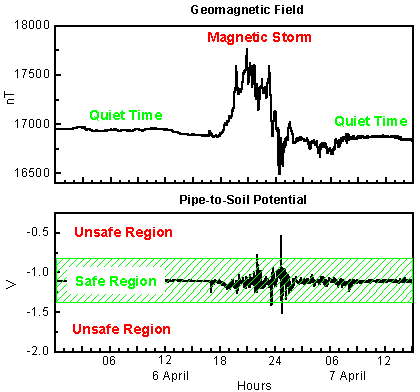
Time-varying magnetic fields induce time-varying electric currents in conductors. Variations of the Earth's magnetic field induce electric currents in long conducting pipelines and surrounding soil. These time-varying currents, named "telluric currents" in the pipeline industry, create voltage swings in the pipeline-cathodic protection rectifier system and make it difficult to maintain pipe-to-soil potential in the safe region. During magnetic storms, these variations can be large enough to keep a pipeline in the unprotected region for some time, which can reduce the lifetime of the pipeline. As an example, the geomagnetic storm on the 6-7 April 2000 is shown on the figure. The top panel shows geomagnetic field variations at Ottawa magnetic observatory; the bottom panel shows the pipe-to-soil potential difference on a pipeline in Canada, recorded at the same time. During the magnetic storm the pipe-to-soil potential difference went outside the safe region. That can increase the possibility of corrosion.
Effect of Pipeline Characteristics
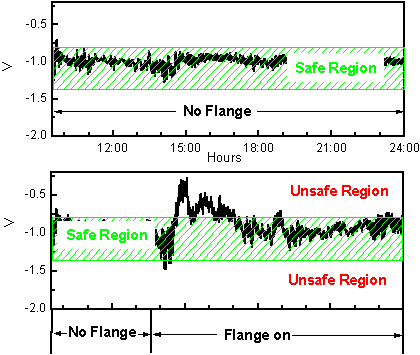
The whole pipeline system is quite complicated. It consists of a gathering system of pipelines from the oil or gas fields; a transmission pipeline (often two parallel pipelines); a distribution network of pipelines close to the city. To follow a certain route, pipelines must bend. For the electrical separation of one part of the pipeline from the other or from the processing plant, engineers use insulating flanges. They stop electrical currents but allow gas or oil to flow. All the above mentioned pipeline features cause the pipeline system to respond to the geomagnetic variations in a more complicated way. The figure shows an example of records which have been taken at different test posts of the same pipeline.
To help engineers monitor the pipe-to-soil potential and make some predictions of the expected values during a geomagnetic storm, some research and mathematical modeling of the pipeline response to the geomagnetic variations has been carried out in the Ottawa Geomagnetic Laboratory. More about this research can be found in various papers and conference proceedings by the members of our research team:
Introduction
The telegraph was the first man-made system to involve the use of long electrical conductors and consequently was the first such system to be affected by magnetic disturbances. In the history of these effects there are many accounts of the telegraph system being unusable when aurora were observed overhead. There are even accounts of telegraph engineers using the "celestial power" associated with the aurora to send messages.
In the 20th century the technology for cable communications changed but all cables have been affected by the induced voltages produced by geomagnetic disturbances.
Early Effects
In the early days of the telegraph, a variety of methods were used for recording the signal transmitted over the wires. Bain's "chemical telegraph" used specially prepared paper: current from a stylus caused a chemical reaction leaving a coloured mark on the paper. During the magnetic storm of February 19, 1852, the current increased so much that a "flame of fire" followed the pen and set fire to the paper.
The early phone system had ground connections only through lightning protection devices at the ends of the lines. The breakdown voltage of these devices was higher than would be produced during most geomagnetic disturbances. However, during the magnetic disturbance on March 24, 1940, phone communications in the US were disrupted and voltages in excess of 500 V were thought to have occurred. In Sweden, several magnetic storms produced voltages large enough to start arcing in the carbon protectors. Once started, the arc continued even while the voltage began to decrease and the carbon protectors were heated to such an extent that they caught fire.
How Magnetic Storms Affect Cable Systems

In the twentieth century open wire systems were replaced by coaxial cables. The introduction of coaxial cables increased the bandwidth of communication systems but required repeater amplifiers to compensate for the cable losses. These repeaters are connected in series with the centre conductor of the cable and are powered by a direct current supplied from the terminal stations at the ends of the cable. The varying magnetic field that occurs during a geomagnetic disturbance induces a voltage directly into the centre conductor of a coaxial cable. This voltage will add to or subtract from the voltage coming from the cable power supply.
Effects on Continental Cable Systems
On 4 August, 1972, an outage of the L4 coaxial cable system in the mid-western US occurred during a major geomagnetic disturbance. An examination of this disturbance showed that, at the time of the outage, the Earth's magnetic field had been severely compressed by the impact of high-speed particles from the Sun.
The resulting magnetic disturbance had a peak rate of change of 2200 nT/min, observed at the Geological Survey of Canada's Meanook Magnetic Observatory, near Edmonton, and a rate of change of the magnetic field at the cable location estimated at 700 nT/min. The induced electric field at the cable was calculated to have been 7.4 V/km, exceeding the 6.5 V/km threshold at which the line would experience a high current shutdown.
Effects on Submarine Cable Systems
During the magnetic storm of February 10, 1958, transatlantic communication from Clarenville, Newfoundland, to Oban, Scotland proceeded as alternately loud squawks and faint whispers as the naturally induced voltage acted with or against the cable supply voltage.
Effects on Fibre Optic Cables
New submarine cables are using optical fibres to carry the signals, but there is still a conductor through the cable to carry the power to the repeaters. At the time of the March 1989 storm, a new transatlantic telecommunications fibre-optic cable was in use. It did not experience a disruption, but large induced voltages were observed on the power supply cables. Future cables, because of improvements in the fibre optics, may use fewer repeaters and require a lower driving voltage. However, downsizing the power feed equipment without taking account of the induced voltages may leave future systems more vulnerable to geomagnetic effects.
The Sun emits electromagnetic radiation that spans a continuum of wavelengths from radio, through microwave, infrared, visible, ultraviolet x-ray and beyond. Ultraviolet radiation interacts with the upper atmosphere to form an ionized layer known as the ionosphere. Radio waves interact with the ionosphere in a variety of ways depending on their frequencies. For frequencies below about 30 MHz, the ionosphere can act as a reflector, and this property permits very long distance radio communications around the world. At higher frequencies, above 30 MHz, radio signals usually pass through the ionosphere.
The ionosphere sometimes becomes disturbed as a reaction to some types of solar activity and, as a result, radio wave propagation may be degraded or disrupted. Solar flares emit electromagnetic radiation, such as x-ray emissions which can cause increases in ionization in the lower ionosphere, with consequent phase shifts in low frequency radio signals and increased absorption (fading) in HF and VHF radio signals. The wide spectrum of radio noise emitted from a flare may interfere with a wanted radio signal. These effects may be experienced at all latitudes. At frequencies above 30 MHz, unexpected reflections of the radio waves by the ionosphere may cause radio interference. Ionospheric irregularities may produce fluctuating signals (a phenomenon known as scintillation) and may distort the paths of radio waves. During geomagnetic storms and the associated ionospheric disturbances, scintillation activity may affect certain applications of navigational aids such as the Global Positioning System (GPS). See Space Weather Effects on GPS.
Solar flares may be accompanied by streams of very energetic particles that travel at near the speed of light. These particles (mainly protons and electrons) enter the upper atmosphere in the regions near the magnetic poles. As a result, the lower levels of the polar ionosphere become very ionized, with severe absorption of HF and VHF radio signals. Such an event is known as a polar cap absorption (PCA) event and may last from days to weeks, depending on the strength of the stream of solar particles and the location of the source region on the Sun. HF radio communication in polar regions is often impossible during PCA events.
Large clouds of plasma (ionized gases), known as Coronal Mass Ejections (CME), can be emitted from the Sun, and may reach Earth, causing disturbances in the geomagnetic field and in the ionosphere. Coronal holes, regions of the solar corona with diminished x-ray emissions, also emit streams of charged particles that can result in disturbances of the ionosphere. Ionospheric disturbances are especially significant at auroral latitudes, such as over much of Canada, and during magnetic storms and substorms at these latitudes, HF radio communication may be unreliable.
Download the booklet on Space weather – Effects on Technology.